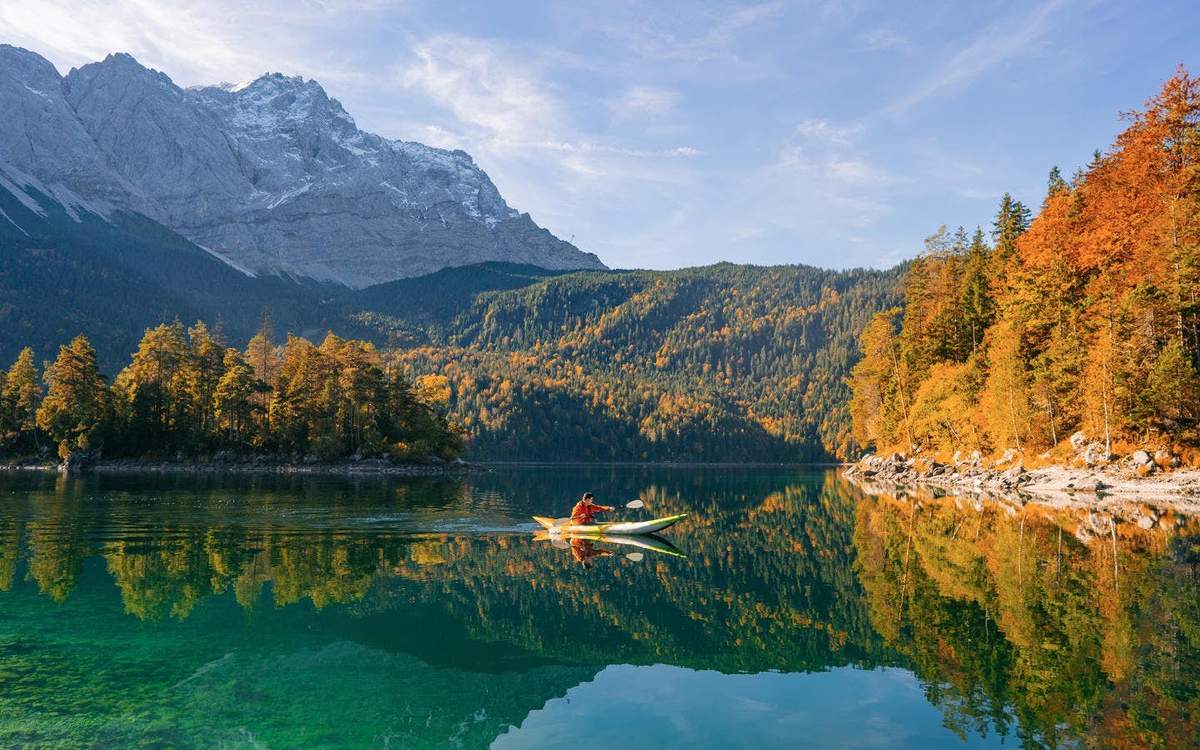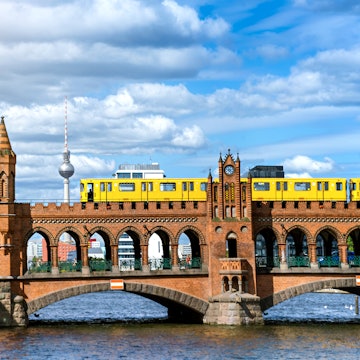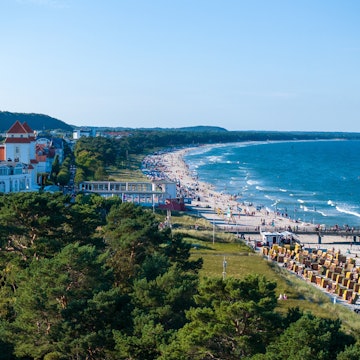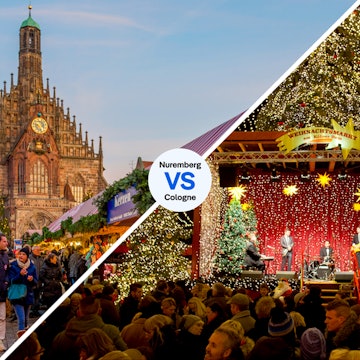
Hiking, climbing, cycling, paddling and more: Germany's best adventure activities
Feb 3, 2020 • 6 min read

The mountains of Garmisch-Partenkirchen offer rich pickings for hikers, skiers and rock climbers. Simon Koeppl / EyeEm / Getty Images
From tough Teutonic trails to silky ribbonesque rivers just asking to be run, Germany is an underrated adventure powerhouse.
Yet with such Alpine scene-stealing European neighbours as Switzerland, France and Austria, the land of lederhosen often gets overlooked by those who favour active outdoor excitement over beerhall high-jinks.
But there are long-distance trails to be hiked and ridden, rivers to be paddled, cliffs to be climbed and adventures aplenty to be had, in the Rhineland massifs the Harz and Ore mountains and, of course, in Bavaria, Germany’s most famous outdoor playground. Here you can ascend to a wintersports heaven, crowned by Germany’s highest peak, the 2962m Zugspitze.
There is no doubt that Germany can offer rich pickings for those with an adventurous eye.

Hiking
In Germany, many long-distance trails offer a slice of everything: steep and serious terrain with mountain views, undulating tracks through forests, hiking paths linking historic villages and remote walks where you can still spot wildlife, including black bears and lynx.
Saxon Switzerland and the Thuringian Forest are respectively home to Germany’s most scenic long-distance walks: the 112km Malerweg – known as the Painter’s Way for its historical association with landscape artists – and the Rennsteig (168km), a ridge walk in the Thuringian Highland. The latter is not to be confused with the equally stunning 320km Rheinsteig from Bonn to Wiesbaden, a trail shadowing the Rhine and featuring challenging climbs and a variety of landscapes of both natural and cultural significance.
The Saxon-Bohemia region in the east is home to the Kammweg, a 289km hiking route that’s one of Central Europe’s oldest, while the 660km Goldsteig in eastern Bavaria is Germany’s longest notable trail, its route traversing woodlands and riverscapes and overlooking a line-up of 1000m-plus peaks.
Other popular trekking areas include the Harz and the Black Forest. Those seeking more vertiginous challenges can, in summer, check out the multitude of routes crammed into and around the Bavarian Alps.
Climbing
One of the best sport climbers in history, Wolfgang Güllich (1960–1992), was German, so it’s no surprise the country features world-famous crags that, while not known for their size, are respected for their interest and difficulty levels. The region of Südpfalz was the crucible for Güllich’s talent, with trad climbing, sport climbing and bouldering all on offer, and its topography boasting 120 towers and 200 massifs.
The limestone crags of the Frankenjura present more world-class climbing; the region is notable – in addition to its high density of traditional breweries – for more than 6500 routes, including the world’s first recognised 9a (5.14d) grade climb, "Action Directe". Güllich specifically invented the now commonly used campus board training tool to build the strength required for the route, which features long dynamic moves off single-finger pockets.
The Elbe Sandstone Mountains are also well regarded by climbers. Free climbing is popular but via ferrata offers exposure for the non-experienced. There are an estimated 14,000 routes up the Elbe’s more than 1100 freestanding pinnacles.

Road cycling
Germany has more than 200 dedicated long-distance cycle routes, so the two-wheeled traveller is spoiled for choice. These well-signposted – often traffic-free – pathways offer a more adventurous way to hop between historic cities, or to explore areas of great natural beauty. Take your pick from a pedal through dramatic river valleys, along rugged coastlines, past crystal clear Alpine lakes, into dense forests and over imposing mountain passes.
If navigation isn’t your strong point, then following the banks of one of Germany’s many rivers is a great way to go. Popular rides include the 860km Elberadweg or the legendary Danube – a riverside route revered by cycle tourists worldwide. If history is your thing, then a pedal along the Rhine is a must. Be sure to add an extra few days into your schedule to explore one of the hundreds of medieval castles scattered along the banks of this trail, which runs from Kleve in the north west, to Lake Constance in the south east.
If you prefer your waters to be more of the ocean blue type than river green, then head up to the fringes of the Baltic Sea, where a 1095km Flensburg-to-Usedom trail skirts Germany’s northern coast. The riding here is mostly on a flat paved surface, with some sections of sand or cobble to negotiate. Expect to encounter dramatic chalk cliffs, shallow sandy bays, windswept peninsulas, lush green forests and the Unesco-listed medieval towns of Wismar and Stralsund.
Not to be missed are also some lung-busting rides on quiet trails through the mountains of the Black Forest in the south west of the country.

Mountain biking
Although backroad-touring adventures such as the 860km Elberadweg are immensely popular, there is also a bevy of off-road options.
To find singletrack, rough riders gravitate to the regions of Sauerland, the Eifel, the Harz (which has more than 2200km of dedicated mountain-bike trails) and the Black Forest, commonly regarded a mountain biking paradise.
The 200km Rennsteig Cycle Trail travels through the Thuringian Forest Nature Park and the Slate Mountains, with 120km of the route on forest tracks.
Bikepark Winterberg is Germany’s premier go-to for downhillers and freeriders. It features a multitude of creative obstacles and ranks among the best bike parks in Europe, the 9km of freeride trails being the biggest draw. And the Palatinate Forest Park is another forest gem, featuring 300km of pathways through west Germany’s largest unified wooded area.

Snowsports
Lying just below the Zugspitze, Garmisch-Partenkirchen is the epicentre of all things snowsports, its credentials founded on hosting the 1936 Winter Olympics and 2011 Alpine World Ski Championship. It boasts 20km of pistes ranging from 700m to 3km, a snowboard park and 40km of cross-country (XC) trails. True XC adherents, however, will base themselves out of nearby ski village Oberammergau, which has 90km of routes, plus a few steep pistes on the slopes of the Laber (1683m).
For those seeking more intense thrills, the Dammkar-tunnel near Mittenwald on the opposite side of Garmisch-Partenkirchen, has a 40% incline that’s one of Germany’s most challenging.
Allgäu boasts 500km of downhill slopes, including some deep-snow off-piste skiing, and with 200 ski lifts it easily lays claim to being Germany’s largest continuous ski field.

Paddling
There’s plenty of water sloshing around Germany in the form of lakes, canals and some of Europe’s greatest rivers – think the Danube and the Rhine – with more than 40,000km of predominantly flat water for paddling enthusiasts to explore.
Paddling the big rivers is popular, but you have to share with big cruisers. Perhaps the most appealing multiday paddle is in the Müritz National Park. Here you can pack supplies and meander through a mosaic of lakes, pitching the tent bankside at night. Similar paddle-camp explorations can be had in the Spreewald, south of Berlin; around Lake Constance (the second largest in Europe); and on the Schleswig-Holstein lakes, from Eutin to Kiel. Another astonishing Alpine puddle that can be explored by kayak or paddleboard is Lake Eibsee below Zugspitze in Grainau, Bavaria.
For something different, paddle the small Altmühl between the Rhineland and the Danube, which includes an underground tunnel section that was artificially constructed to supply the Rhine- Danube canal. Spooky but fun.
Though Germany can’t hold a whitewater flag to many global destinations, it does have a few runs worth getting skirted up for, including the steep descent of the Eistobel on the Argen River in Bavaria. The Gutach in the Black Forest is another fast flowing, narrow and tough run. For guaranteed conditions, try the artificial whitewater of Augsburg Eiskanal in Augsburg – constructed for the 1972 Munich Olympic Games.
You might also like:
Going green in Germany's Black Forest
Back to nature: 8 rewilding projects you can visit in Europe
The naked truth about naturism in Germany















